Physical Address
304 North Cardinal St.
Dorchester Center, MA 02124
▪ Discoid lupus erythematosus: a subset of chronic cutaneous lupus erythematosus ▪ Lupus profundus: a variant of lupus panniculitis ▪ Lupus erythematosus tumidus: tumid lupus
There are several variants of cutaneous lupus, defined in part by the location and depth of the inflammatory infiltrate
Acute cutaneous lupus involves primarily the epidermis and upper dermis and is usually associated with active systemic disease
Subacute cutaneous lupus involves primarily the epidermis and upper dermis and most patients have photosensitivity and anti-SSA/Ro autoantibodies during the course of their disease; the majority do not have significant systemic involvement (renal, CNS or cardiopulmonary)
Discoid lesions of lupus involve the epidermis, upper and lower dermis, and adnexal structures, and they can scar; the majority of patients do not have clinically significant systemic disease
Lupus erythematosus tumidus involves the dermis but there is no prominent epidermal involvement and lesions do not scar
Lupus panniculitis involves the subcutaneous tissue and may result in disfiguring depressed scars due to lipoatrophy
Lupus erythematosus is a multisystem disorder that often affects the skin. Cutaneous lesions can be a source of disability and, on many occasions, an indicator of internal disease.
The term “lupus erythemateaux” was first used by Cazenave in the mid-1800s . Cazenave and others helped to articulate the difference between lupus erythematosus (LE) and lupus vulgaris, a clinical variant of cutaneous tuberculosis. Due in part to observations of Hutchinson, Osler and Jadassohn, it was recognized that cutaneous lesions of LE may be associated with significant internal abnormalities, including arthritis, nephritis, serositis, cytopenias and neurologic disease. In 1964 and during the following years, Dubois developed the concept of lupus as a spectrum of disease, ranging from isolated cutaneous lesions to life-threatening, multi-organ disease. Gilliam also developed the concept of a spectrum of cutaneous disease, and, in 1979, along with Sontheimer and Thomas, clearly separated and named the entity now known as subacute cutaneous lupus erythematosus (SCLE) . The description was virtually identical to that of “ANA-negative” lupus (see Ch. 40 ), reported by Maddison, Provost and Reichlin in 1981 .
Important diagnostic advances included discovery of the LE cell phenomenon by Hargraves, Richmond and Morton in 1948; identification of ANA by Friou in 1957; description of the lupus band test by Burnham, Neblett and Fine in 1963; and the association of specific clinical manifestations of lupus with specific autoantibodies by a variety of investigators . With regard to skin disease, the associations of anti-Ro (also known as anti-SSA) autoantibodies with neonatal lupus by Weston et al. in 1981 and with subacute cutaneous lupus (SCLE) by Sontheimer et al. in 1982 are noteworthy milestones.
Antimalarial therapy in the form of quinine was used for cutaneous lupus by Payne in 1894. By the late 1950s, synthetic antimalarials had become a mainstay of therapy. Systemic corticosteroids and other immunosuppressive agents came into use during the mid twentieth century.
Systemic lupus erythematosus (SLE) is a common disease with significant morbidity and mortality. The strongest factor affecting risk for lupus is gender : women with SLE outnumber men by at least 6 : 1 . Since SLE occurs most commonly in women during their childbearing years, it is likely that hormonal factors influence susceptibility. Consistent with the importance of sex steroids in the expression of disease, lupus is rare in prepubertal children. With regard to patients who have only cutaneous lesions, there appears to be a somewhat lower female-to-male ratio (perhaps 3 : 1), but there is still a female predominance.
Ethnicity is also a major risk factor, and its effect in some populations is almost as strong as that of gender. The prevalence of SLE is fourfold higher in African-American women as compared to Caucasian American women (4 in 1000 vs 1 in 1000) . In addition, African-Americans tend to develop disease at an earlier age and have a higher mortality rate. A long-term study of a multi-ethnic cohort of 587 SLE patients from Texas, Alabama and Puerto Rico found that African-Americans and Hispanics from Texas had more severe disease than Caucasian Americans or Hispanics from Puerto Rico . It is likely that Caucasian populations in Europe have a similar prevalence of lupus as do Caucasians living in the US. It also appears that the prevalence of lupus among both Asians and Latin Americans is similar to that of Caucasian Americans.
Highlighting the importance of skin disease in LE, population-based studies indicate that there are approximately as many patients who have cutaneous LE without concurrent SLE as there are patients who have SLE .
The pathogenesis of cutaneous LE is complex, and it involves an interaction between genetic and environmental factors. The latter include ultraviolet radiation (UVR), medications, cigarette smoking, and possibly viruses. This interplay triggers a complex inflammatory cascade of cytokine, chemokine and inflammatory cell responses that include cells residing within as well as recruited to the skin. Overall, the lichenoid tissue reaction, defined as epidermal basal cell damage and a band-like lymphocytic infiltrate in the upper dermis, characterizes most subsets of cutaneous LE. It involves activation of keratinocytes, endothelial cells, and skin dendritic cells plus the production of type I interferons (IFNs), followed by the recruitment and activation of CD4 + and CD8 + cytotoxic T cells. The end result is cytotoxic keratinocyte damage.
Genes that can affect overall immunoreactivity include those whose protein products are involved in B- and T-cell function, innate immunity, immune complex clearance, apoptosis, ubiquitination, DNA methylation or cellular adhesion . Examples from all these gene classes, in addition to genes with unknown function, have been implicated in some way in human or animal models of SLE ( Table 41.1 ; see Ch. 4 ).
| GENES ASSOCIATED WITH SYSTEMIC LUPUS ERYTHEMATOSUS | |
|---|---|
| B- and T-cell function | HLA-DR – major histocompatibility complex, class II |
| BLK – B lymphoid tyrosine kinase | |
| BANK1 – B-cell scaffold protein (with ankyrin repeats) 1 | |
| CTLA4 – cytotoxic T lymphocyte antigen 4 | |
| FCGR2B – Fc fragment of IgG, low affinity IIb, receptor (CD32) | |
| LYN v-yes-1 – Yamaguchi sarcoma viral related oncogene homolog | |
| IKZF1 – Ikaros | |
| PTPN22 – protein tyrosine phosphatase, non-receptor type 22 (lymphoid) | |
| STAT4 – signal transducer and activator of transcription 4 | |
| PDCD1 – programmed cell death 1 | |
| IRAK1 – interleukin-1 receptor-associated kinase 1 | |
| ETS1 – v-ets erythroblastosis virus E26 oncogene homolog 1 | |
| TNFSF4 – tumor necrosis factor (ligand) superfamily, member 4 | |
| IL21 – interleukin 21 | |
| Innate immunity | IRF5 – interferon regulatory factor 5 |
| TNFAIP3 – tumor necrosis factor, alpha-induced protein 3 | |
| SPP1 – secreted phosphoprotein 1 (osteopontin) | |
| TREX1 – three prime repair exonuclease 1 (see text) | |
| TYK2 – tyrosine kinase 2 | |
| IRAK1 – see above | |
| STAT4 – see above | |
| RASGRP3 – RAS guanyl releasing protein | |
| SLC15A4 – solute carrier family 15 member 4 | |
| Immune complex clearance | FCGR3A – Fc fragment of IgG, low affinity IIIa, receptor (CD16a) |
| FCGR3B – Fc fragment of IgG, low affinity IIIb, receptor (CD16b) | |
| CRP – C-reactive protein, pentraxin-related | |
| ITGAM – integrin, alpha M (complement component 3 receptor 3 subunit; CD11b) | |
| C4A – complement component 4A | |
| C4B – complement component 4B | |
| C2 – complement component 2 | |
| C1Q – complement component 1, q subcomponent | |
| Apoptosis | ATG5 – autophagy related 5 homolog |
| STAT4 – see above | |
| Ubiquitination | UBE2L3 – ubiquitin-conjugating enzyme E2L 3 |
| TNFAIP3 – tumor necrosis factor, alpha-induced protein 3 | |
| TNIP1 – TNFAIP3 interacting protein 1 | |
| DNA methylation | MECP2 – methyl CpG binding protein 2 (Rett syndrome) |
| Cellular adhesion | ITGAM – see above |
| Other/unknown | PXK – PX domain containing serine/threonine kinase |
| ICA1 – islet cell autoantigen 1 | |
| SCUBE1 – signal peptide, CUB domain, EGF-like 1 | |
| NMNAT2 – nicotinamide nucleotide adenylyltransferase 2 | |
| XKR6 – XK, Kell blood group complex subunit-related family, member 6 | |
| KIAA1542 | |
Both genetic background based upon ancestry and mutations in specific genes contribute to the clinical heterogeneity in cutaneous LE. For example, the incidences of photosensitivity and discoid LE (DLE) differ in those of northern versus southern European ancestry , and SCLE is associated with the HLA-B8-DR3 extended haplotype (including TNF2 ), as well as C2 and C4 deficiencies . Genes previously associated with SLE, e.g. TYK2 , IRF5 and CTLA4 , also confer an increased risk for developing DLE and SCLE , while mutations in TREX1 , which encodes a DNA exonuclease, are associated with familial chilblain lupus . In the latter patients, dysfunction of the exonuclease leads to an accumulation of IFN-stimulatory nucleic acids.
Autoantibodies clearly play a role in SCLE and neonatal lupus, where anti-SSA/Ro (more specifically, anti-SSA/Ro60 and anti-SSA/Ro52) and anti-La autoantibodies are frequently observed (see Ch. 40 ); in the case of neonatal lupus, these antibodies are transmitted transplacentally. Blocking the function of either SSA/Ro60 or SSA/Ro52 presumably predisposes one to these diseases. Of note, SSA/Ro60 plays an important role in cell survival following UVR, possibly via binding to misfolded non-coding RNAs and targeting them for degradation, and mice which lack SSA/Ro60 develop a lupus-like syndrome . SSA/Ro52 has a known regulatory role in inflammation, targeting both interferon regulatory factor 3 (IRF3) and IRF8 for degradation ; thus, antibodies to SSA/Ro52 may be proinflammatory. Alternatively, or in addition, these autoantibodies could lead to disease via activation of proteins and cells of the immune system, following immune complex formation.
Both ultraviolet B (UVB) and ultraviolet A radiation have been implicated in exacerbation of cutaneous LE, although UVB is a more efficient cause of photo-induced changes in the skin . UVR induces apoptosis, which leads to translocation of cellular and nuclear antigens , and there may also be a reduction in the clearance of apoptotic cells . In addition, UVR increases keratinocyte production of SSA/Ro52 .
A number of proinflammatory cytokines, including tumor necrosis factor (TNF)-α, interleukin (IL)-1, IFN-γ, HMGB1 (high-mobility group box 1), and IL-18 are induced by UVR . There is also upregulation of antimicrobial peptides within the skin as well as a release of e xtracellular t raps (ETs) by dying n eutrophils (NETosis); these traps are composed of a lattice of DNA, histones, and cytoplasmic proteins ( Fig. 41.1 ) . Following UV irradiation of keratinocytes, a complex array of chemokines, including chemokine (C-C motif) ligand 5 (CCL5), CCL20, CCL22, and chemokine (C-X-C motif) ligand 8 (CXCL8), is produced. Of note, there is an increase in these chemokines within lesions of cutaneous LE, likely leading to leukocyte recruitment to the skin . These effects require adhesion molecules, with activation of endothelial cells (increased expression of ICAM-1, VCAM-1 and E-selectin) and induction of ICAM-1 on basal keratinocytes .
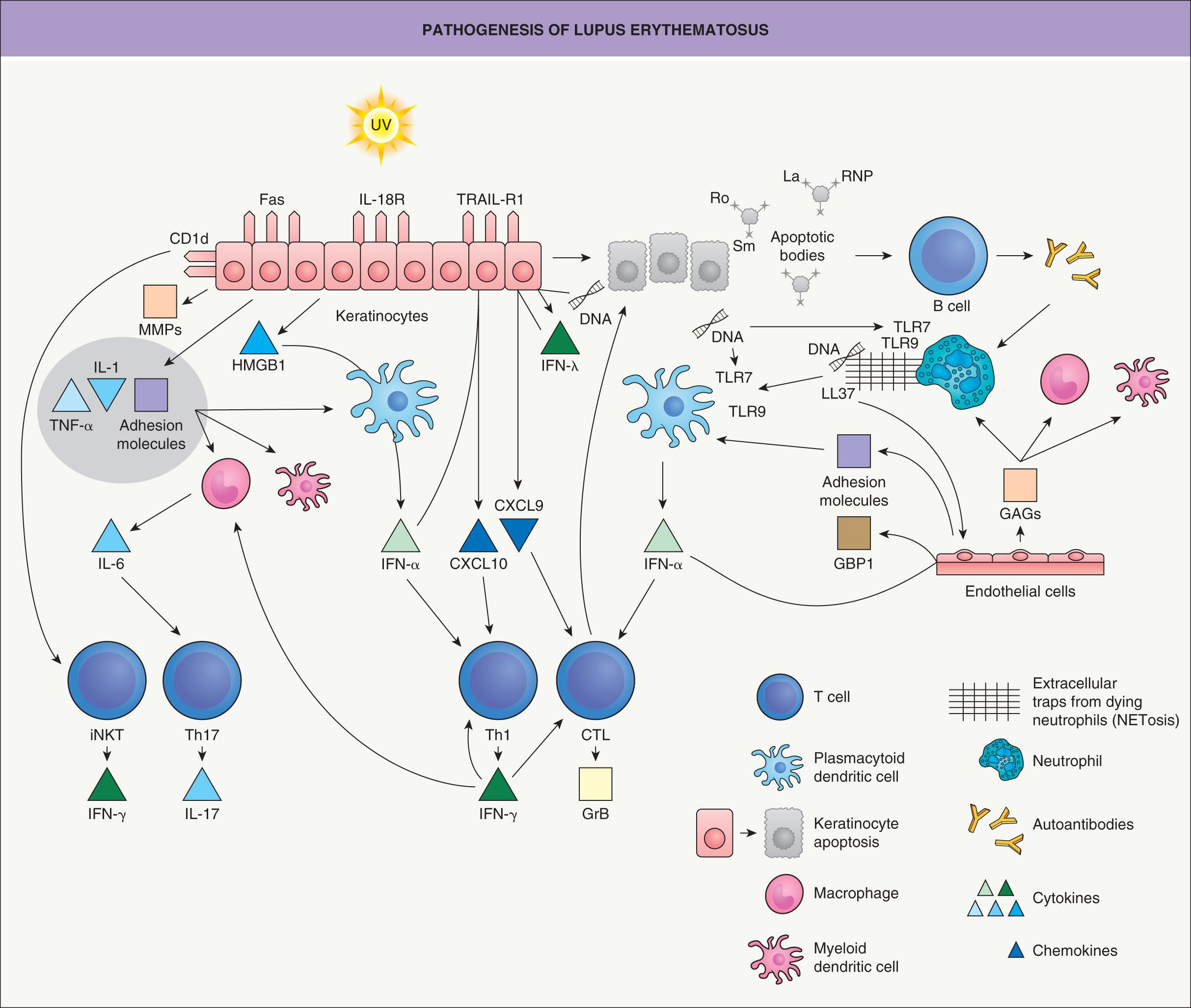
IFN is another cytokine that plays a role in the pathogenesis of cutaneous LE. Increased secretion of IFN can result from: binding of apoptotic cells to Fcγ receptors on macrophages; binding of viral pathogens, DNA, RNA or immune complexes to Toll-like receptors on plasmacytoid dendritic cells; and single nucleotide polymorphisms (SNPs) in genes that encode proteins in the IFN pathway . Notably, an increase in proteins upregulated by IFN, including the chemokines CXCL9 and CXCL10, has been observed in the skin of patients with cutaneous LE (see Fig. 41.1 ) . IFN-α further drives the differentiation of monocytes to plasmacytoid dendritic cells, which are potent producers of IFN-α/β, thus forming an amplification loop . Increased numbers of plasmacytoid (CD123 + ) and myeloid dendritic cells have been found within cutaneous LE lesions . Epidermal and dermal dendritic cells can acquire keratinocyte-derived antigens and prime CD8 + T cells to these antigens within the skin-draining lymph nodes . Corroborating evidence for the role of IFN-α is provided by the induction of cutaneous LE in patients receiving IFN-α for other medical conditions. The increased IFN signature seen in SLE has also been detected in peripheral blood mononuclear cells from patients with DLE and SCLE, but not those with LE tumidus .
The IFN-upregulated chemokines can recruit CXCR3-positive CD4 + and CD8 + T cells to the skin, as well as immature plasmacytoid dendritic cells, contributing to the characteristic interface infiltrate of cutaneous LE . In addition, via the production of IFN-α, plasmacytoid dendritic cells drive the activation and expansion of T cells. There is also evidence for the presence of granzyme B and TIA1 (poly(A)-binding protein), two cytotoxic granule-associated proteins involved in apoptosis, in the skin of all subsets of cutaneous LE, although somewhat less so in SCLE, suggesting that there are fewer CD8 + T cells in SCLE . In patients with disseminated, scarring DLE, high numbers of circulating CCR4 + cytotoxic T cells were detected . One study found decreased numbers of Foxp3 + CD4 + CD25 + T regulatory cells in the skin, but not the blood, of cutaneous LE patients, and Treg cells are known to downregulate the immune response .
A scenario that integrates current theories regarding the pathogenesis of several subsets of cutaneous LE is shown in Fig. 41.1 . In the proposed model, a response to UVR triggers cytokine, chemokine, and antimicrobial peptide production by keratinocytes as well as endothelial cell activation, thereby initiating the immune response. In the context of genetic and environmental risk factors, a complex cascade ensues that includes activation of dendritic cells, release of IFN, activation of T cells, and production of chemokines; a positive feedback loop ultimately results in a lichenoid tissue reaction.
The most commonly used classification of cutaneous lesions in LE is that of Dr. James Gilliam . He segregated skin lesions into those that are specific and those that are not specific based upon whether the histopathology demonstrated an interface dermatitis or not, respectively. Within the category of specific cutaneous lesions, he subdivided these into acute cutaneous LE, subacute cutaneous LE, and chronic cutaneous LE ( Fig. 41.2 ). This choice of terms was based upon the observation that three distinct types of cutaneous LE are commonly seen: the often transient lesions of acute cutaneous LE (ACLE) typified by malar erythema; the frequently long-lived, intensely inflammatory discoid LE (DLE) lesions which can lead to permanent disfiguring scars; and a photosensitive eruption characteristically more long-lasting than ACLE but without the potential for atrophy or scarring, for which the term subacute cutaneous LE (SCLE) was coined. Typically grouped within the chronic cutaneous LE category are the less common disorders LE tumidus, lupus panniculitis, and chilblain lupus (see Fig. 41.2 ), despite the observation that characteristic lesions frequently lack an interface dermatitis, especially LE tumidus.
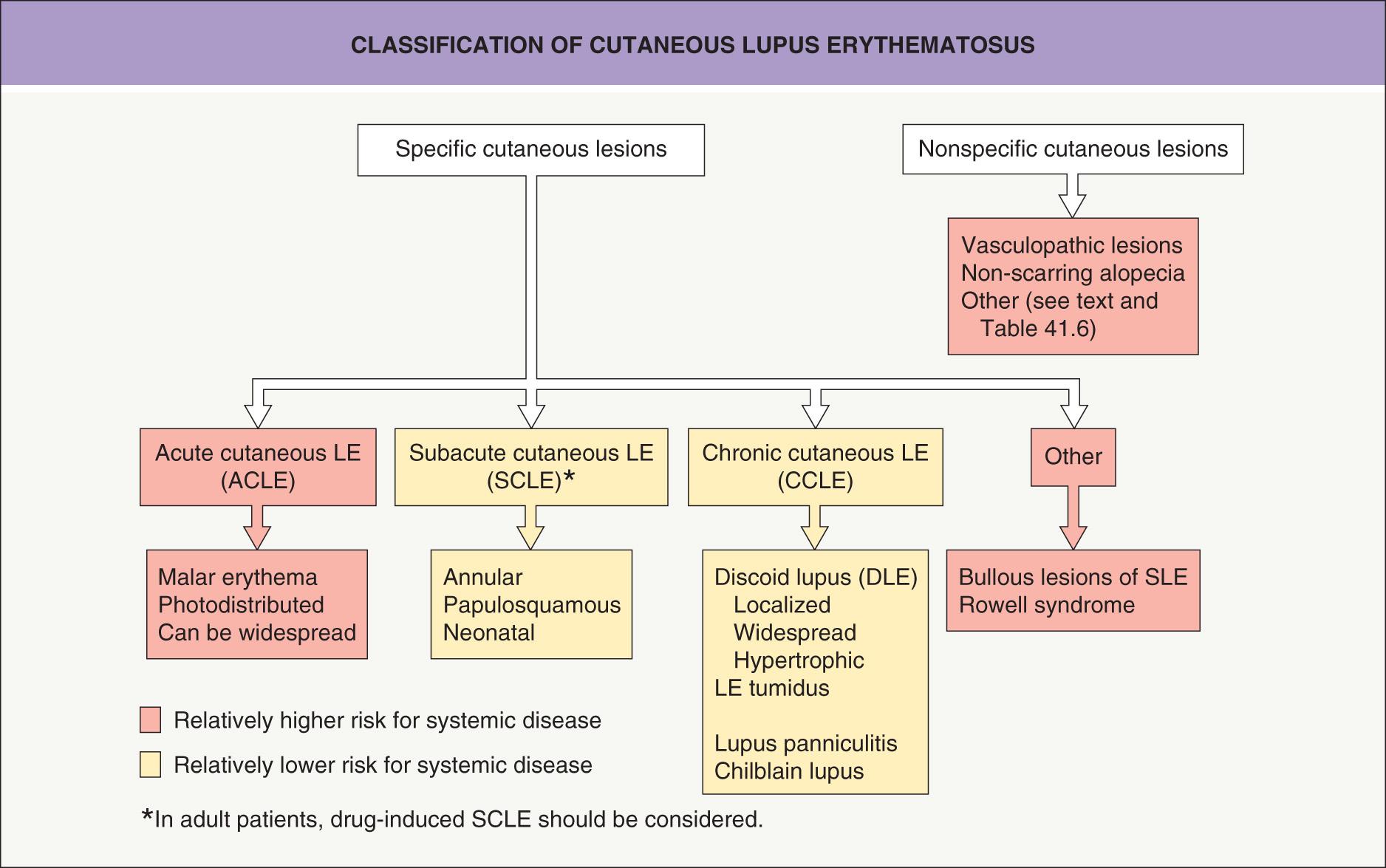
Formal studies have not been done comparing duration of disease activity for the various types of cutaneous LE, and there is a considerable range in the duration of activity within each subtype. Patients with SCLE lesions may have a chronic, relapsing course, while DLE or LE tumidus lesions may have a relatively short duration due to resolution or effective disease control. In fact, some authorities have proposed that LE tumidus should be removed from the chronic category and be given its own category, intermittent cutaneous LE . These controversies aside, Gilliam's classification schema has proven utility in the organization of the various types of cutaneous LE and it is the basis for the classification herein, accompanied by a focus on the morphology and histopathology of lesions ( Fig. 41.3 ). The three major forms of cutaneous LE will be discussed first, followed by the remaining entities outlined in Fig. 41.2 .

Discoid lesions represent one of the most common skin manifestations of lupus and they are most frequently found on the face, scalp and ears ( Fig. 41.4 ), but may be present in a more widespread distribution ( Fig. 41.5 ). It is unusual for discoid lesions to be present below the neck without lesions also being present above the neck. Occasionally, discoid lesions develop on mucosal surfaces, including the lips, nasal mucosa, conjunctivae, and genital mucosa.
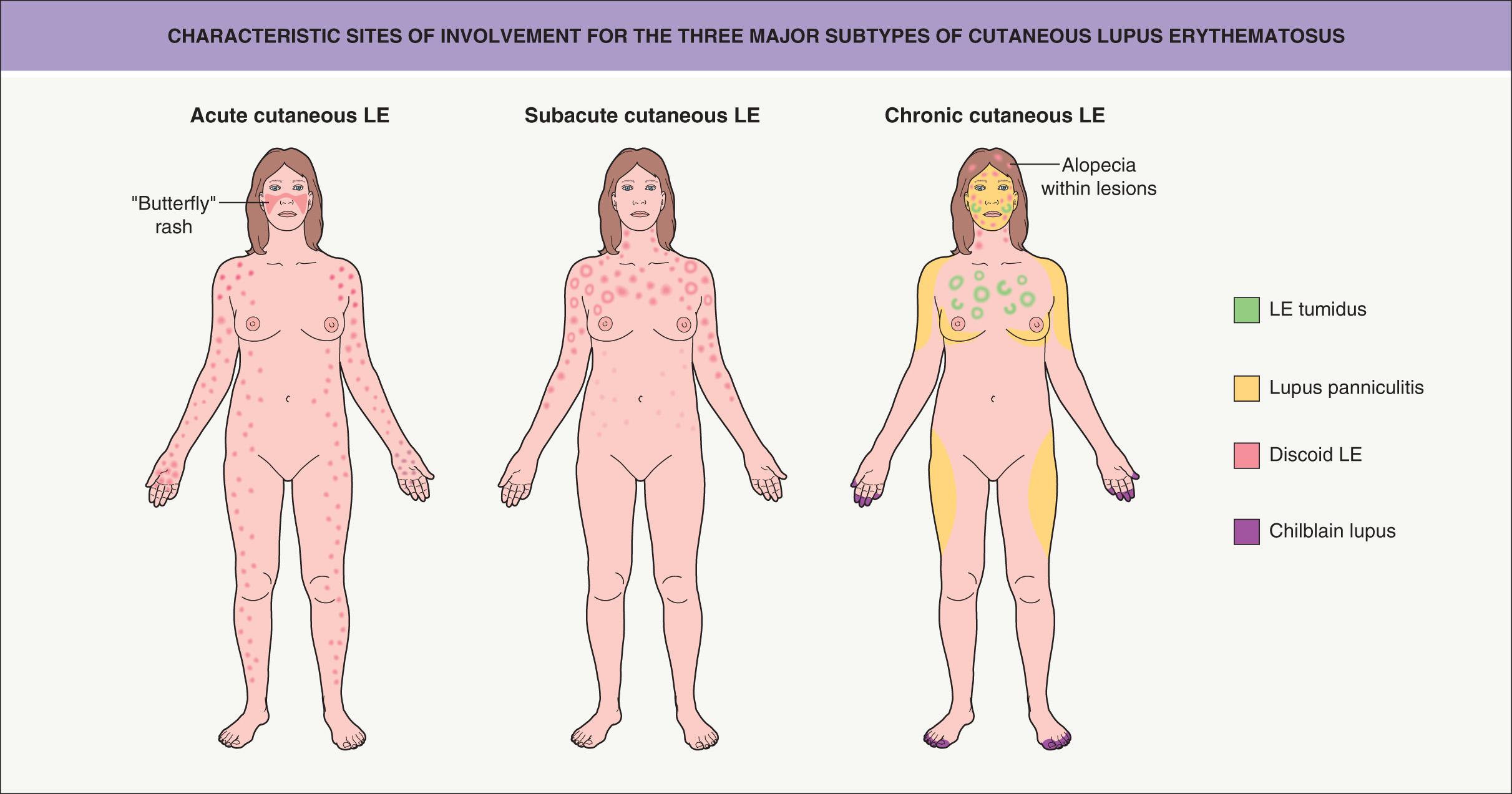
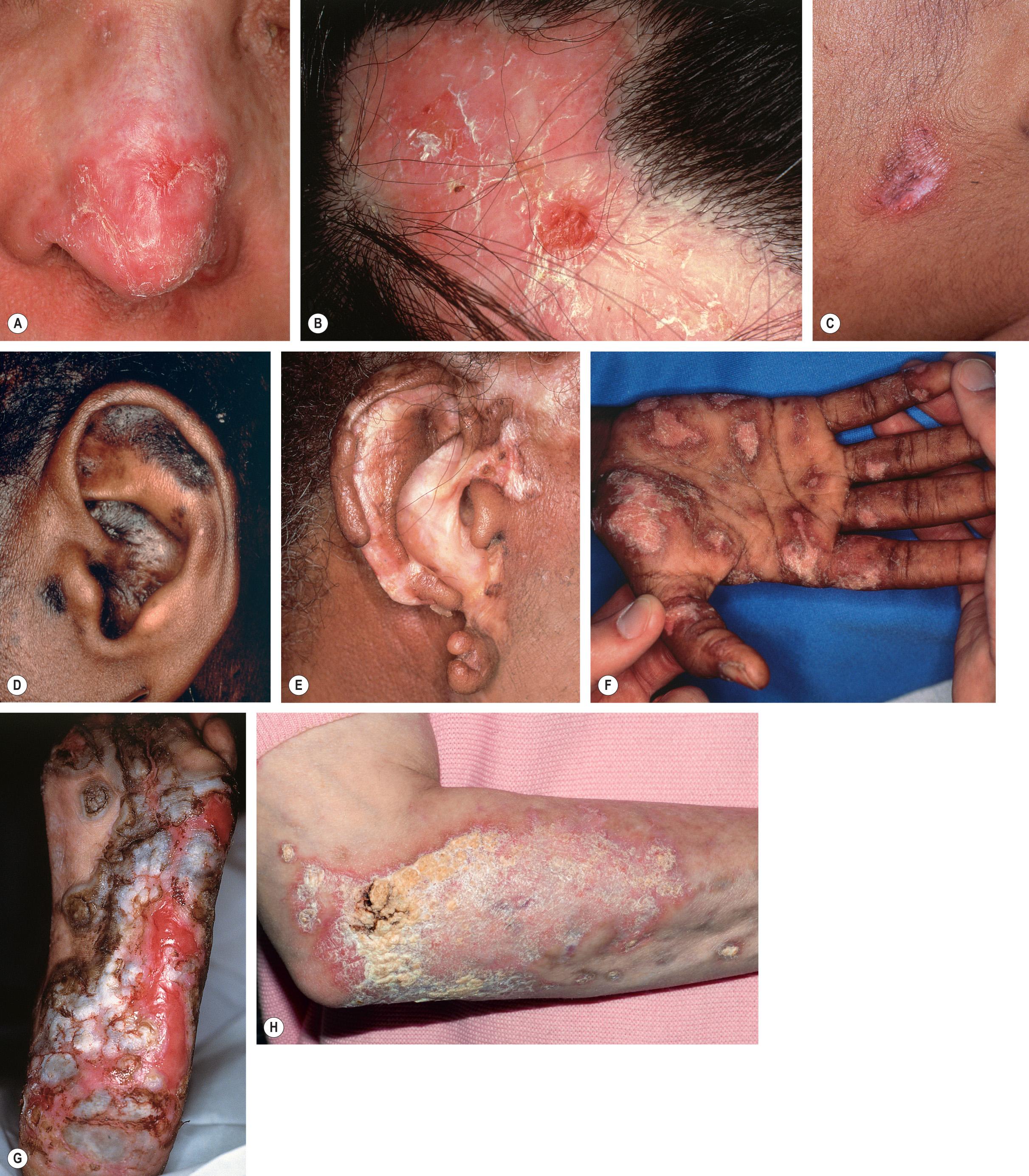
Some patients with discoid lesions exhibit a photodistribution, and sun exposure appears to have a role in lesional development. However, many patients have discoid lesions on sun-protected skin, and there is no clear association between sun exposure and their development.
Discoid lesions have the potential for scarring, and, over time, a substantial proportion of patients develop disfiguring scarring. Active lesions are intensely inflammatory, with a pronounced superficial and deep dermal inflammatory infiltrate. As a result, on palpation, active lesions typically feel thicker and firmer than surrounding uninvolved skin. The adnexa are prominently involved, with follicular plugging and scarring alopecia commonly observed. Dyspigmentation is a common sequela noted in longstanding lesions, typically with hypopigmentation in the central area and hyperpigmentation at the periphery ( Fig. 41.6 ), but sometimes with vitiligo-like depigmentation. Rarely, squamous cell carcinoma develops in a longstanding discoid lesion.
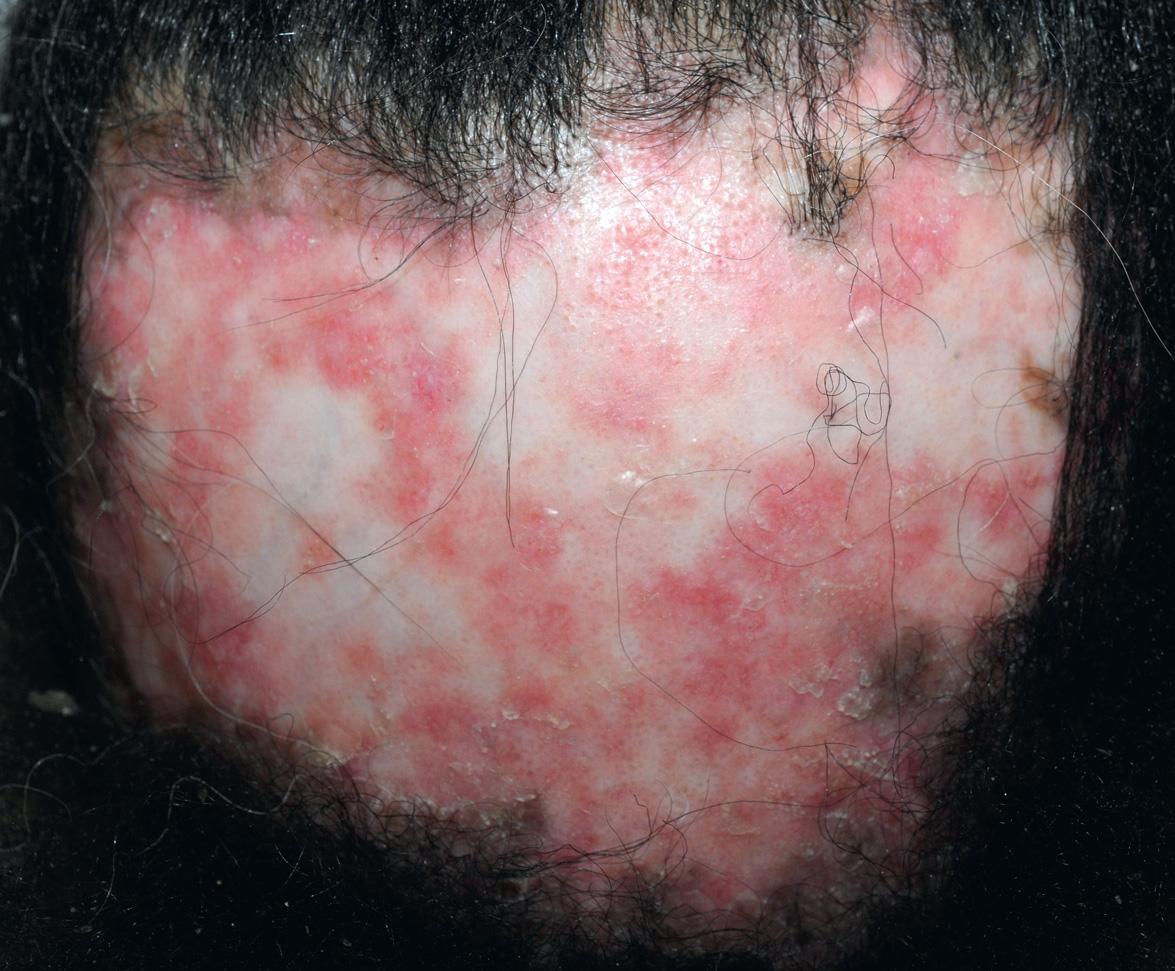
Patients who present with discoid lesions may have associated arthralgias, but, over time, only ~10–20% of these patients eventually meet the classification criteria for SLE (see below) . Many of these patients meet criteria based primarily upon mucocutaneous disease rather than serious internal disease , and the majority of those who progress do so within five years. The risk may be higher in patients with widespread (disseminated) discoid lesions .
An unusual variant of DLE is hypertrophic DLE, characterized by thick scaling overlying the discoid lesion or occurring at the periphery of the discoid lesion. The intensely hyperkeratotic lesions are often prominent on the extensor arms (see Fig. 41.5H ), but the face and upper trunk may also be involved. Frequently, there are typical discoid lesions present in other locations.
Patients with SCLE typically note photosensitivity. Their lesions most frequently occur on sun-exposed skin. It is notable that the midfacial skin is usually spared, while the sides of the face, upper trunk and extensor aspects of the upper extremities are commonly involved ( Fig. 41.7 ; see Fig. 41.4 ) . In some patients, the disease may be mild, with only a few small scaly patches appearing after sun exposure.
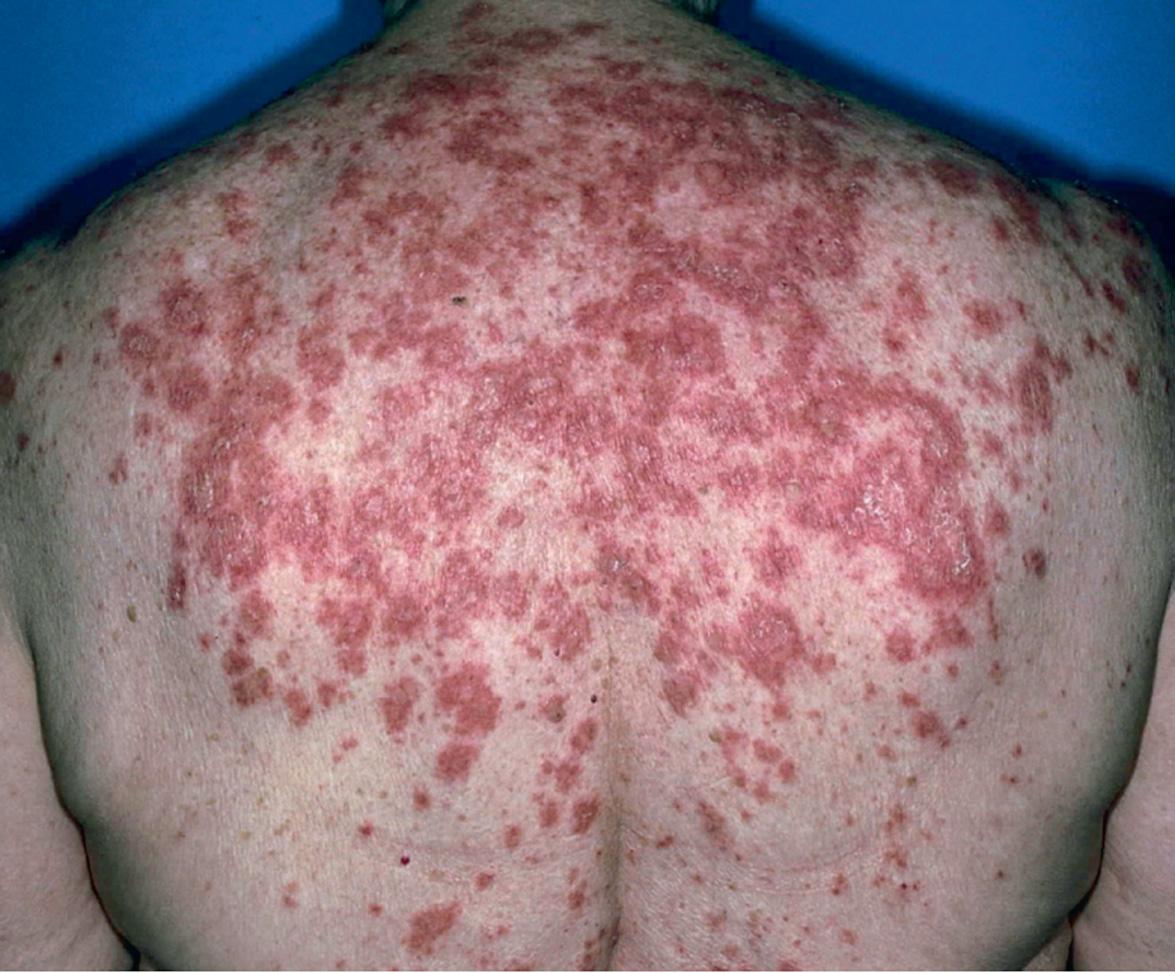
Lesions of SCLE may have an annular configuration, with raised pink–red borders and central clearing ( Fig. 41.8 ), or a papulosquamous presentation with a chronic psoriasiform or eczematous appearance. SCLE lesions characteristically have a relatively sparse, superficial inflammatory infiltrate, and, consequently, they are minimally palpable. Lesions often result in dyspigmentation, particularly hypopigmentation or even depigmentation, but develop neither scarring nor dermal atrophy as sequelae.
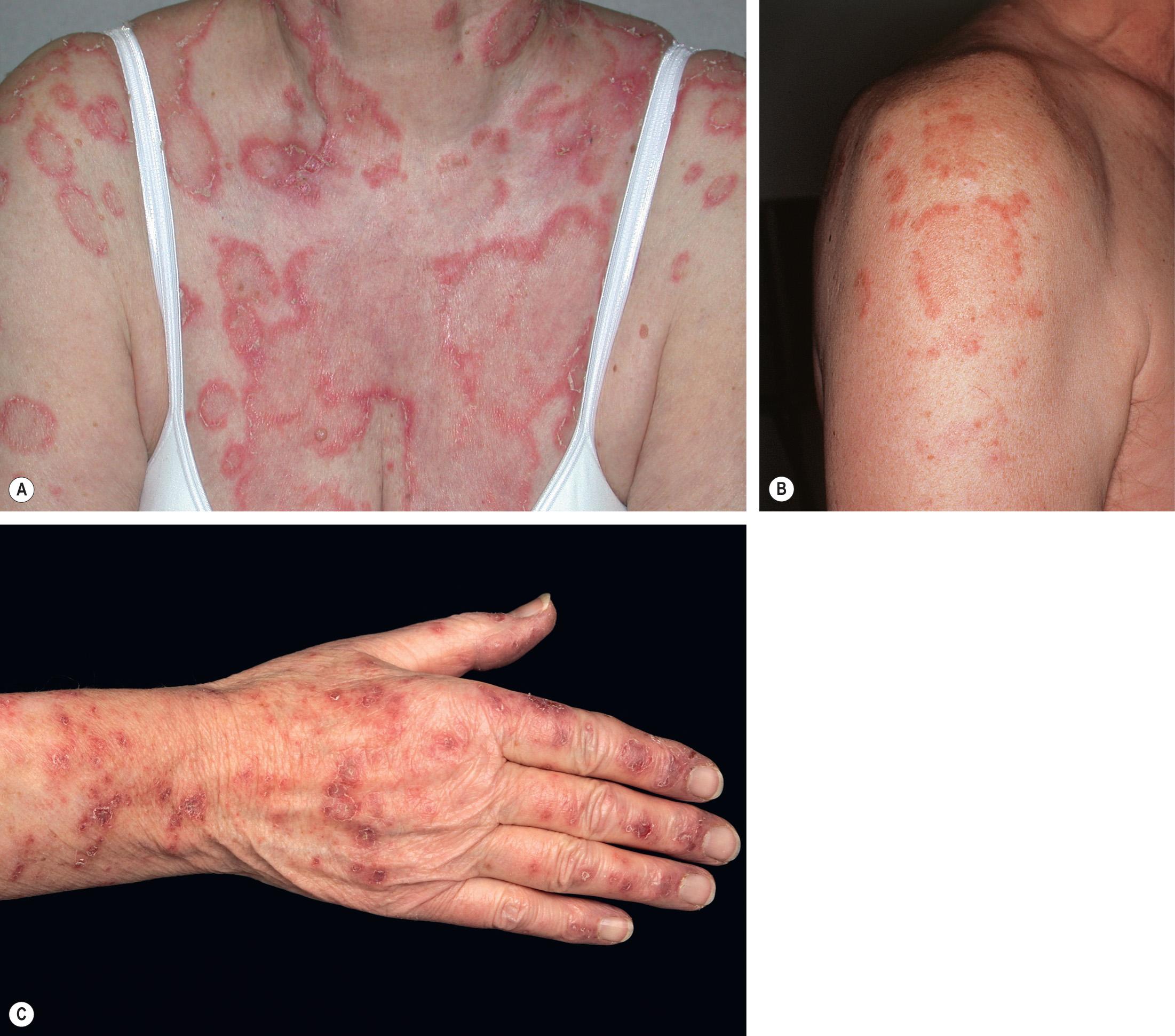
In ~20–30% of patients with SCLE, the disease is linked to medications ( Table 41.2 ). The first drug associated with the development of SCLE was hydrochlorothiazide, but at least 100 agents have been reported subsequently to induce or exacerbate SCLE . A population-based study from Sweden identified (in decreasing order) terbinafine, TNF inhibitors, anti-epileptics, and proton pump inhibitors as the most frequently associated medications . The cutaneous lesions may or may not clear once the medication is discontinued.
| MEDICATIONS ASSOCIATED WITH DRUG-INDUCED SUBACUTE CUTANEOUS LUPUS ERYTHEMATOSUS |
|
* Medications are classified as being more common or having a higher risk if there were >10 cases reported in the literature as of 2016 or the relative risk in reference was ≥2.0. Medications are classified as being less common if there have been 3–10 cases reported and the relative risk was <2.0.
Approximately one-third to one-half of patients presenting with SCLE fulfill 4 or more classification criteria for SLE . An occasional patient may develop significant internal disease, including nephritis . Since anti-SSA/Ro autoantibodies are associated with Sjögren syndrome as well as SCLE, it is not surprising that some patients have features of both conditions, and some may have serious internal manifestations of Sjögren syndrome such as pulmonary or neurologic disease.
An important feature of SCLE, from the standpoint of understanding the pathogenesis of lupus, is its regular association with anti-SSA/Ro autoantibodies (see Ch. 40 ). Although investigators differ in their opinions as to the prevalence of anti-SSA/Ro autoantibodies in SCLE, it is likely that a substantial majority of patients with this condition (~70% in a large series, reported range of 60–100%) have anti-SSA/Ro antibodies .
Become a Clinical Tree membership for Full access and enjoy Unlimited articles
If you are a member. Log in here